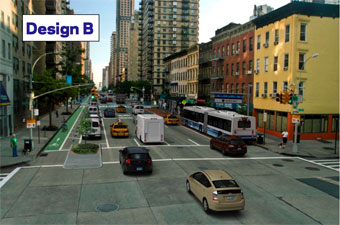Bus Stops, Not Bike Lanes, the Hot-Button Issue at Manhattan CB 6
 One CB 6 member praised the "Design B" template for East Side avenues because of its bike safety benefits. Image: NYCDOT/MTA
One CB 6 member praised the "Design B" template for East Side avenues because of its bike safety benefits. Image: NYCDOT/MTALast night NYCDOT and the MTA showed their plans for enhanced bus service and safer streets on the East Side of Manhattan to the Community Board 6 transportation committee. There was no vote, but the meeting was a chance to see how ideas like separated bike lanes and bus bulbs play in the type of public forum that, typically, is slow to embrace change.
The CB 6 district, which extends from 14th Street to 59th Street east of Lexington, sees some of the heaviest traffic on the East Side corridor. It includes access points to the free Queensboro Bridge and the Queens Midtown Tunnel, and it’s a street safety desert, with high rates of pedestrian injuries and almost no bicycle infrastructure to speak of. Residents tend to fall on the affluent end of the income spectrum and not own cars, with last night’s crowd of about 35 definitely skewing to the 60-and-older side.
I don’t think we’ve ever covered CB 6 here on Streetsblog. If last night’s meeting was any indication, it may not be the stodgiest in Manhattan. Calls to extend DOT’s plan for a protected bike path through the Midtown gap — several blocks of First Avenue approaching the Queensboro and a longer stretch of Second Avenue down to 34th Street — outnumbered complaints about the idea of new bike infrastructure by a noticeable margin.
One CB member praised the agencies’ "Design B" configuration, which includes a separated bikeway, "because of
the bike safety aspect," and the biggest applause of the evening went
to 12-year-old Clark Vaccaro, who asked for a continuous protected lane through Midtown. Anti-bike sentiment rarely surfaced aside from one cranky question about whether cyclists deserve a separated lane.
Perhaps one factor at work is that, as safety data on DOT projects at Ninth Avenue, Grand Street, and Broadway continues to pile up, the case for separated bike lanes has become a universal case for pedestrian and bike safety. Last night, DOT Bicycle Coordinator Josh Benson revealed that pedestrian injuries are down 29 percent on Ninth, 28 percent on Grand, and 40 percent on Broadway since the installation of protected bikeways.
If DOT is considering extending the proposed East Side protected bikeway as they revise their plan, however, they’re not letting on. At the most congested locations, Benson explained, a separated bike lane would cause more motorists to "invade the bus lane," adding that DOT might extend the bikeway at some future date: "We’ll have to look at these segments in a couple of years and ask, ‘Is traffic changing?’" Attending these presentations, it’s hard not to wonder whether DOT would feel more confident proposing a bolder plan had the state legislature approved congestion pricing two years ago.
By far the most contentious issue at this community board meeting had nothing to do with bicycling. Since Select Bus Service will replace limited-stop service on the M15 route, but make fewer stops, the elimination of a limited stop at 50th Street, where you can transfer to the crosstown M50, and the potential addition of an SBS stop at 28th Street, near Bellevue Hospital, were the real hot-button issues for this community board. (Local service would not be affected.)
With much of the projected gain in bus speeds culled from reducing the amount of time buses spend stopped at stations, the MTA’s Ted Orosz, director of long-range bus planning at New York City Transit, warned that the addition of a few stops in each community district would compromise the whole plan. "If the SBS stops everywhere the limited stops now, it’s going to be a limited with lipstick," he said.